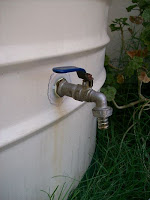 |
| The yogurt culture is already in the milk and the glasses are waiting to be filled. |
The other things I use are screw top glas jars to store the joghurt and an esky to keep the mixture warm for the joghurt to set, plus hot water for sterilisating the glass jars and for filling the esky.
The procedure is simple: I make about 3.5 litres in one lot. I heat up two litres of cold water, add 1 litre of milk and four cups of skim milk powder. I stir it well and heat it to 80degrees Celsius, then take it off the stove to let it cool. I try to get the temperatures pretty accurate.
I then choose my glass jars and sterilise them in boiling water. I use about 10 jars of various sizes and pre-heat them in handwarm water in the sink before I leave them for about 30 seconds each in a big pot with boiling water. I do the same with the lids, to ensure they are clean and germ free. I reheat the boiling water after about three jars to make sure it is close to boiling and does the job. I cover my kitchen bench with a fresh tea towel and let the water drain off the glasses.
When then milk is cooled down to just below 50 degrees I mix in the joghurt culture. I use a joghurt high in beneficial bacteria, if possible organic joghurt. So far I have never used a started culture but will explore that avenue. I put the filled jars into the esky which I already filled with the hot water left over from preheating and sterilising the jars. I ensure the jars are nearly submerged and I add boiling water until the inside water temperature is about 48 degrees.
The jars will be left in there for at least 4 hours. After that I take one out and turn it over to see whether the yoghurt has set enough. I let it cool down and put it in the fridge when room temperature, usually over night. This method has done me well and the product is delicious. I can't wait to eat it.
Great websites with information about making your own yogurt :
Cuising.com.au
Pick me yard
How to make yogurt
Wiki - How to make yogurt




